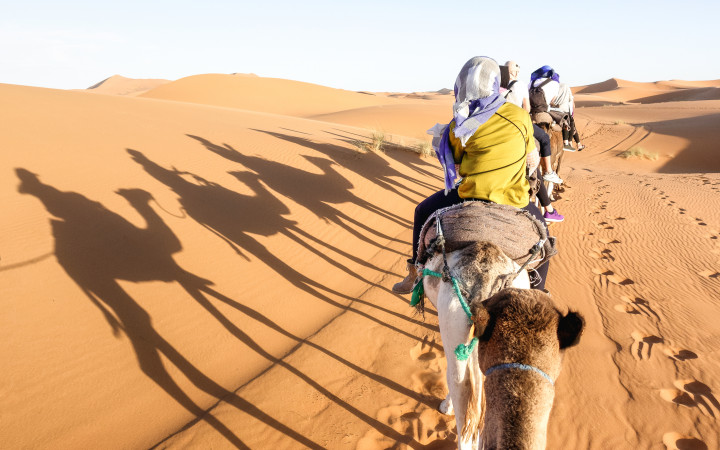Today’s Wonder of the Day was inspired by WonderTeam. WonderTeam Wonders, “Was the Sahara Desert once a green oasis?” Thanks for WONDERing with us, WonderTeam!
Where can you find cacti, sand dunes, and rolling tumbleweeds? How about camels, meerkats, and lizards? If you’re thinking of the desert, you’re right!
A desert is a place that has fewer than 10 inches of rain each year. Earth is home to many of these places. There’s America’s Death Valley and Asia’s Gobi Desert. And not all deserts are hot. Antarctica and the Arctic also contain deserts—cold ones! But today’s Wonder of the Day is about perhaps the most famous desert of all: the Sahara.
The Sahara Desert covers much of northern Africa. And it’s huge! It’s the third-largest desert in the world, right behind the Antarctic and Arctic deserts. In fact, the Sahara is nearly as large as the entire United States.
Today, you won’t find many people living in the Sahara. It’s home to fewer than one person per square mile. You’ll go many miles without seeing plant or animal life, either. Of course, water is almost nowhere to be found.
But that wasn’t always the case! No, around 11,000 years ago, the Sahara wasn’t a desert at all. Instead, it was covered in plant life. It also held bodies of water. There was even a “megalake” that covered over 42,000 square miles.
So what happened? What caused the lush, green oasis to turn into the dry, sand-covered wasteland it is today? As with most good questions, this one has more than one answer.
In part, the change in the Sahara was natural. Rainfall in the area has never been steady, due to changes in the Earth’s orbit. These changes affect the amount of Sun energy that reaches the Sahara. With more energy comes more rainfall across the Sahara. And with less energy comes less rain.
Because of these changes, the Sahara’s climate has always been irregular. It has moved slowly between humid and dry for thousands of years. However, sometime between 8,000 and 4,500 years ago, that changed. The area went from humid to dry much quicker than normal. And it’s stayed dry since then.
So, what happened? Scientists aren’t sure. Some experts believe human activity may have caused the change. They’ve found that, as humans moved across the Sahara, plant life died out. One hypothesis is that early humans allowed goats and other livestock to overgraze in the Sahara. This led to less moisture in the area. It also caused erosion of topsoil, so plants couldn’t grow. Human use of fire may have also added to the problem.
Did people turn the green Sahara into a desert? Maybe. Experts say they need to do more research before they can say for sure. However, archaeologists have found that an ancient African civilization once turned part of the Sahara back into a green oasis, if only for a short time.
Between 1 and 500 C.E., the Garmantes built a large community in the Sahara Desert. They even used their advanced understanding of irrigation to grow crops. Experts found the remains of their buildings in 2011.
Today, the Sahara Desert is still growing. Experts say it’s at least 10 percent larger than it was a century ago. Researchers estimate that about two-thirds of the growth is due to natural changes, while the remaining growth may be caused by climate change.
Will the Sahara ever be a green oasis again? It’s certainly possible. However, it would take many years of human efforts as well as natural changes. What do you think it would be like to live in a green Sahara? What other deserts would you transform? A more lush, green Earth could be at your fingertips!
Standards: NGSS.ESS2.D, NGSS.ESS3.B, NGSS.ESS3.C, C3.D3.Geo.4, C3.D2.Geo.5, C3.D2.His.2, CCRA.L.3, CCRA.L.6, CCRA.R.4, CCRA.R.10, CCRA.R.1, CCRA.R.2, CCRA.SL.1, CCRA.SL.2, CCRA.W.3, CCRA.L.1, CCRA.L.2




